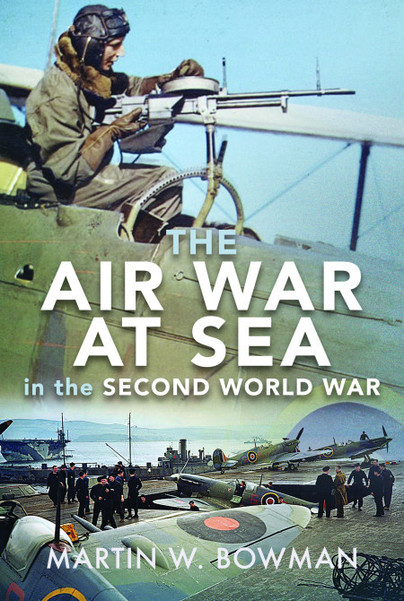
The Air War at Sea in the Second World War. By Martin W. Bowman. Pen and Sword Aviation, Barnsley, 2023.
Reviewed by Darren Puttock
Martin W. Bowman’s “The Air War at Sea in the Second World War” is a compelling journey through the treacherous skies of one of the most significant periods in maritime history. From the anxious days of the German invasion of Norway in April 1940 to the preparations for the invasion of mainland Japan, the book offers a sweeping view of the aerial conflicts that helped to shape the outcome of World War Two.
With over a hundred published titles to his name, including works on aviation history and the Second World War, Bowman is a well-respected aviation historian and photographer. His decades of meticulous research and firsthand interviews with veterans form the backbone of this narrative, lending it a personal and raw quality that distinguishes it from conventional historical accounts.
The narrative unfolds across the immense expanses of the Atlantic, Mediterranean, and Pacific theatres, encompassing the operations of both the British Air Arm and the United States Navy. The chronological scope is of a grand scale, capturing pivotal moments from the intense hunt for the Bismarck and Tirpitz to the devastating attack on Pearl Harbor. Bowman also dives deep into the perilous game of hunting the hunters, as aircrews spent countless hours scanning the empty waves for U-boats in a ponderous Sunderland. From the decisive Battle of Midway, the gruelling Battle for the Solomons, and the sweeping manoeuvrers of the British Pacific Fleet, Bowman spans the entirety of the vastness of the grand battles of the Pacific from the perspective of those who fought in the air.
One of the distinguishing features of Bowman’s narrative is its exclusive focus on British and American perspectives. The author consciously omits the Japanese and German sides, providing an insightful exploration of the Allied experiences in the air war at sea. This deliberate choice allows for a more nuanced and detailed examination of the challenges, victories, and losses faced by the Allied forces. Bowman thus avoids the potential dilution of the narrative’s coherence, as the reader is not pulled in multiple directions by the complexities of contrasting perspectives. This enables a more concentrated examination of the factors that shaped the course of the conflict and allows for a more immersive journey into the lives of the Allied aviators, fostering a stronger emotional resonance with the reader.
This true strength of Bowman’s storytelling lies in his ability to convey the intensity of combat through the eyes of those who lived it, as firsthand accounts make the reader privy to the visceral and emotional aspects of aerial warfare. The stories are not just historical records but living testimonies, transporting readers to the cockpit and the deck of aircraft carriers during intense personal battles that were ultimately what led the Allies to operational and strategic success. An interesting facet of his narrative is the prevalence of the anecdotes of members who had to escape a stricken aircraft by parachute. Failure rates were low thanks to rigorous testing, strict quality control and the dedication of the team packing the chutes; however, as Bowman details, failures did occur. The palpable relief of those who looked up to see a fully deployed chute is conveyed expertly by Bowman, and one cannot help but think of the pilots of the previous war who were not afforded this option. Whether by accident or design, this theme through Bowman’s narrative does an exceptional job of revealing to the reader the endless dangers facing those who fought in the air.
As the reader navigates through the chapters, it becomes evident that Bowman has successfully achieved a delicate balance between scholarly rigor and narrative fluidity. The extensive research is evident in the rich detail with which he describes the various campaigns, aircraft, and personalities involved. Yet, this wealth of information never overwhelms the reader, thanks to Bowman’s skilful storytelling that maintains a brisk pace throughout. The author’s writing style is both accessible and engaging, making the complexities of the second world war in the air comprehensible to a broad audience. Whether one is a casual reader with a passing interest in World War II or an avid enthusiast well-versed in the subject, Bowman’s narrative caters to a diverse readership.
In conclusion, “The Air War at Sea in the Second World War” by Martin W. Bowman stands as a testament to the author’s dedication to preserving and recounting the stories of those who served in the air during this pivotal era. It is a comprehensive and deeply human exploration of a crucial aspect of World War II, offering readers an immersive experience into the challenges, triumphs, and sacrifices of the men who fought amidst the clouds and waves. Whether searching for a summer read or research material, this book is a reading experience that is as informative as it is captivating and is sure to satisfy all who choose to add it to their bookshelf.



